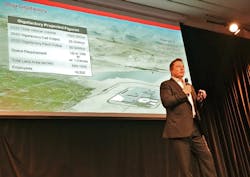Tesla may seek to double size of Gigafactory in Nevada
By BD+C Staff
When work began on the Tesla Gigafactory in January, the Sparks, Nev., facility was proposed to total 10 million sf. The new plan makes the original vision almost cutesy.
Treehugger reports that Tesla Motors purchased an additional 1,200 acres next to the Gigafactory and is looking to buy an additional 350 acres.
If Tesla continues to make the plant larger, it will go from four blocks to seven blocks and could make the Gigafactory between 17.5 million and 24 million sf. At the high end of that estimate, the Gigafactory would be the world's largest building based on footprint.
At an initial cost of $5 billion, the Gigafactory's goal is to make 50 gigawatt-hours of lithium-ion batteries, or as many as 500,000 batteries, for electric cars by 2020. Tesla is building the plant to provide batteries for the Model 3 car, which will be in production in late 2017 or early 2018. A few other models, such as Tesla’s Model S and Model X SUV, will also have batteries produced there.
Tesla received the land for free from Nevada last September and also was granted $1.3 billion in tax breaks. The first construction phase of the factory—a 900,000-sf facility—is nearly completed and is on track to start equipment installation later this year and battery production in 2016.
